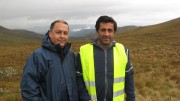ATLIN, B.C. — It’s been a tough time for juniors trying to fund grassroots exploration, but it helps when high-profile investors take notice and decide to support a project. And that’s been the case for Vancouver-based Brixton Metals (TSXV: BBB; US-OTC: BXTMF) and its wholly owned, 270 sq. km Thorn silver-gold property, 130 km southeast of Atlin, B.C.
Even as we land at the Thorn site in a chartered plane, it’s evident that Brixton is busy. A cargo bay full of core boxes speaks to a 4,700-metre, mid-year drill program aimed at further chasing silver-gold-zinc-lead-copper mineralization at Thorn’s Oban breccia zone, and a well-established camp buzzes with activity.
According to chairman and CEO Gary Thomas, Brixton holds no illusions about what it wants to accomplish at Thorn. He explains that his team are explorers at heart, and though Thorn houses many promising outcrops and targets, it’s the high-grade silver-gold potential that has drawn the eye of the venerable U.S. silver and gold producer Hecla Mining (NYSE: HL).
“We’re looking at areas where we can get the substantial grades and intercepts,” Thompson says during a presentation in a stout wooden structure that serves as the company’s technical headquarters. “We’re exploration guys, not mine developers. So we’d look to a company like Hecla that obviously has interest in those types of deals. They want to find new mines, and we’d like to deliver one.”
Thompson says representatives from Hecla are regular visitors at Thorn, and the major ensured Brixton had adequate capital for its mid-year exploration programs via a $2.6-million strategic investment completed in February.
Hecla holds just over a 20% equity interest in Brixton, while its vice-president of corporate development, Don Poirier, sits on Brixton’s board of directors.
And that cash went a long way at Thorn. Though the project was first explored by Kennco Explorations in the late 1950s, it has yet to see the investment needed to map and model a variety of geological structures that make the large-scale property package a true treasure chest of mineralization types.
“I’d say we basically have a little bit of everything here,” Thompson says, pointing out a myriad of rock types in Brixton’s core shack, ranging from crackle breccia to Thorn stock material. Most silver mineralization at the site carries a conventional galena-sphalerite association, while the company’s technical team has also found elevated gold levels when there is pyrite in the system.
“We see silver-copper-gold veins. We have veins that are purely gold and silver with no base metals. Our Oban diatreme-breccia zone is polymetallic, and even within that system we’re seeing gold-rich zones and silver-rich zones,” he continues. “And up at Outlaw we have a possible bulk-tonnage gold zone with fairly weak base metals. We’re trying to show other trends and structures . . . we’re still trying to get a handle on the system.”
Thompson says that he would have preferred to punch a few more exploration holes at alternate targets in mid-year, but due to market conditions, Brixton has tightened its focus to Oban.
The result is a stepout program along 100-metre spacings that focuses on the contact zone at the edges of breccia mineralization uncovered in early 2012, when discovery hole 11-60 cut 95 metres grading 628 grams silver per tonne, 1.71 grams gold per tonne, 0.12% copper, 3.31% lead and 2.39% zinc.
Brixton’s 2013 exploration program was budgeted at $2 million, and Thompson points out that one upside of the mining downturn has been cheaper drill rates, as the company operates its rigs at $300 per metre. A helicopter is transporting drillers and equipment between targets, but Thompson wagers Brixton will likely achieve its drilling goals under budget.
On Aug. 28 the company released assays from 28 holes collared around Oban. Brixton expanded Oban’s mineralized footprint, while determining that the zone remains open at depth, and along strike in several directions. The company’s mid-year drilling discovered more high-grade mineralization hosted within Thorn stock.
Brixton’s biggest strike was 70 metres north of hole 11-60, where hole 13-101 cut 1.3 metres grading 1,275 grams silver and 0.66 gram gold within 12 metres of surface. Lead and zinc credits bump the silver-equivalent grade in the intercept to 1,325 grams. Hole 13-102 was collared on the same drill pad and cut 5 metres averaging 408 equivalent grams silver.
Brixton uncovered two more zones during its program. A sphalerite-galena zone was found 90 metres north of hole 11-60, where 1.3 metres of 650 equivalent grams silver was intersected in hole 13-103 from 140 metres depth. Meanwhile, a pyrite-tetrahedrite zone was discovered 200 metres southwest of Oban, where hole 13-95 cut 5 metres of 227 equivalent grams silver from 130 metres depth.
“I think we’re just getting started,” Thompson says, noting that Brixton hopes its drilling will result in market traction that will help the company explore the project’s full potential. He says getting some excavation equipment at camp would boost exploration efforts.
“There is a lot of promise here,” he says. “We’re seeing some spectacular numbers pretty much all over the place. A lot of the mapping and surface geochemistry we’ve been conducting have really resulted in some eye-popping numbers. For example, there is the extension to the Camp Creek corridor, which was not sampled previously, and we’re seeing some impressive soil assays there.”
Brixton’s results have attracted attention around the industry. On Oct. 10 the company announced a $1.4-million strategic investment, and though Hecla remains involved, it is the participation of prolific mining financier Rob McEwen that has Thompson even more excited. McEwen invested $1 million in Brixton’s private placement, with Hecla tacking on another $430,000.
The company will issue 12 million units at 10¢ per unit, 1.5 million flow-through shares at 10¢ per share and 360,730 common shares at 7.5¢ per share. The issuance pricing is not ideal, but Brixton can begin delineating a maiden resource at Oban this year.
During a helicopter tour of Thorn, Thompson explains that though Oban provides strong results, it is a range of alternate, promising targets that could add value to the project moving forward.
Another aspect of Brixton’s mid-year program was an extensive surface sampling and mapping initiative that includes over 1,200 soil samples. The company’s geologists pulled soil and rock samples from four more mountainous areas around Thorn: Camp Creek, Outlaw, Amarillo and the West La Jaune.
Senior vice-president of geology Sorin Posescu points out promising outcrop at Brixton’s Outlaw showing during the flight, where the company conducted extensive surface sampling in mid-year. Five samples returned values greater than 1 gram gold, including a high of 2.4 grams gold in soil. Results were even better along the Camp Creek corridor, where Brixton hit a high of 13.5 grams gold and 81 grams silver during soil sampling.
Brixton’s final investment during the 2013 field season was an in-depth structural geology study conducted by SRK Consulting. The report was released in September, and posits that an epithermal system associated with magmatic intrusions is likely the cause of the massive sulphide and gold-copper-silver-lead-zinc mineralization at Thorn, including the Oban breccia
body and the quartz-enargite-tetrahedrite veins.
“The highlight is that it looks like we have a northwest–southeast type of maximum extension or trend that runs across the entire property — so all the way from our Outlaw anomaly in the southeast to Amarillo in the northwest,” Thompson says while going over some data sets. “And it does look pretty consistent throughout. We actually took hand samples, and you can see that northeast–southwest dilation, even within a small sample.”
With cash and an upgraded exploration model in hand, Brixton intends on following up at Thorn in the coming months. So though the company’s camp was scheduled to close down following a site visit in August, it seems likely activity will continue over the next weeks. The company had US$1.2 million in working capital at press time.
Brixton’s share price has been hit by volatile precious-metal prices, and an ebbing appetite for exploration-stage projects amongst investors. Thorn is also quite isolated, with the nearest road 50 km away across rough terrain, with sole access provided by a plane via a 700-metre dirt runway.
The company’s stock is down 50%, or 10¢ since the beginning of 2013, and closed at 9.5¢ per share at press time. Brixton has 98 million shares outstanding for a $9.3-million market capitalization.






Be the first to comment on "Brixton poised to solve geological puzzle at Thorn"